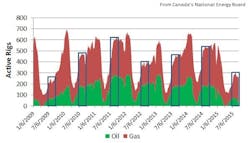BHI: No decline this week for US rig count
The overall US drilling rig count sat unchanged during the week ended Oct. 23, ending 8 straight weeks of declines, according to data from Baker Hughes Inc. (OGJ Online, Oct. 16, 2015). However, oil-directed rigs continued their slide, edging down 1 unit in their 8th straight week of losses.
The overall count had fallen 98 units over those 2 months, hitting its lowest level since May 3, 2002. Compared with this week a year ago, the count is down 1,140 units.
Patterson-UTI Energy Inc., a Houston-based onshore drilling contractor, reported this week that during the third quarter it averaged 105 rigs working in the US, down from the second-quarter average of 122. Its rig count in Canada doubled to 4 from 2.
“Current commodity prices are, of course, negatively impacting drilling activity,” commented Andy Hendricks, Patterson-UTI’s chief executive officer. The company expects its US count in October to average 92, down from 99 in September (OGJ Online, Oct. 9, 2015).
“We recognized $28.9 million of revenues related to early contract terminations in contract drilling during the third quarter,” Hendricks said.
Same story: US oil rigs down, Canada up
During the last 8 weeks, the oil-directed rig count has fallen 81 units and now totals 594, remaining its lowest since July 23, 2010. That count is now down 1,001 year-over-year.
Land-based rigs dropped 2 units this week to 749, down 1,110 year-over-year. Rigs engaged in horizontal drilling were unchanged at 591, ending their 8-week slide. They’re now down 764 year-over-year. Directional drilling rigs edged up a unit to 87.
Two rigs went online offshore Louisiana, bringing the overall US offshore count to 35. The offshore Louisiana count has risen 5 units over the past 3 weeks. Rigs drilling in inland waters were unchanged at 3.
Canada’s rig count, meanwhile, has increased over 4 consecutive weeks, jumping 9 units this week to 190, down 236 year-over-year. Oil-directed rigs also were up for a 4th straight week, gaining 8 units to 84, down 148 year-over-year. Over the past 4 weeks, the overall and oil-directed counts have risen 14 and 18, respectively. Gas-directed rigs edged up a unit this week to 106.
Canada’s National Energy Board this week noted that the country’s summer rig count averaged just 250—the lowest level since the financial crisis of 2009. The number of rigs drilling in western Canada typically ranges between 375 and 600 during the season.
The number of oil-directed rigs fell to 63 this summer from 168 in summer 2014, while the number of gas-directed rigs fell to 188 from 294 over the same period.
NEB reported last week that Canada had the largest drop in rig activity on a percentage basis of any region in the world so far this year (OGJ Online, Oct. 15, 2015).
Texas back leading losses
Texas this week reclaimed a familiar position over the past year among the major oil- and gas-producing states, again leading in losses with a 5-unit drop. At 346, its count is down 40 over 8 consecutive weeks of declines and 560 year-over-year.
The Permian lost 4 units to 229, down 339 year-over-year. The Eagle Ford, however, edged up a unit to 77 after 9 straight weeks of losses during which 25 units went offline.
Pennsylvania and Kansas each declined 2 units to 27 and 7, respectively. The Marcellus lost 3 units to 43 and the Mississippian lost 2 units to 11. For Pennsylvania, its total is the state’s lowest since May 1, 2009.
New Mexico, last week’s losses leader, edged down a unit to 40. West Virginia also lost 1 unit, settling at 17.
Unchanged from a week ago were North Dakota at 63, Colorado at 30, Wyoming at 26, California at 14, Utah at 5, and Arkansas at 4.
Four states reported rig count gains this week. Oklahoma and Alaska each edged up a unit to respective totals of 90 and 12. Ohio increased 2 units to 21. Pushed up by 2 units coming online offshore and a 2-unit rise in the Haynesville, Louisiana led the states with a 5-unit jump to 73.
Contact Matt Zborowski at [email protected].

